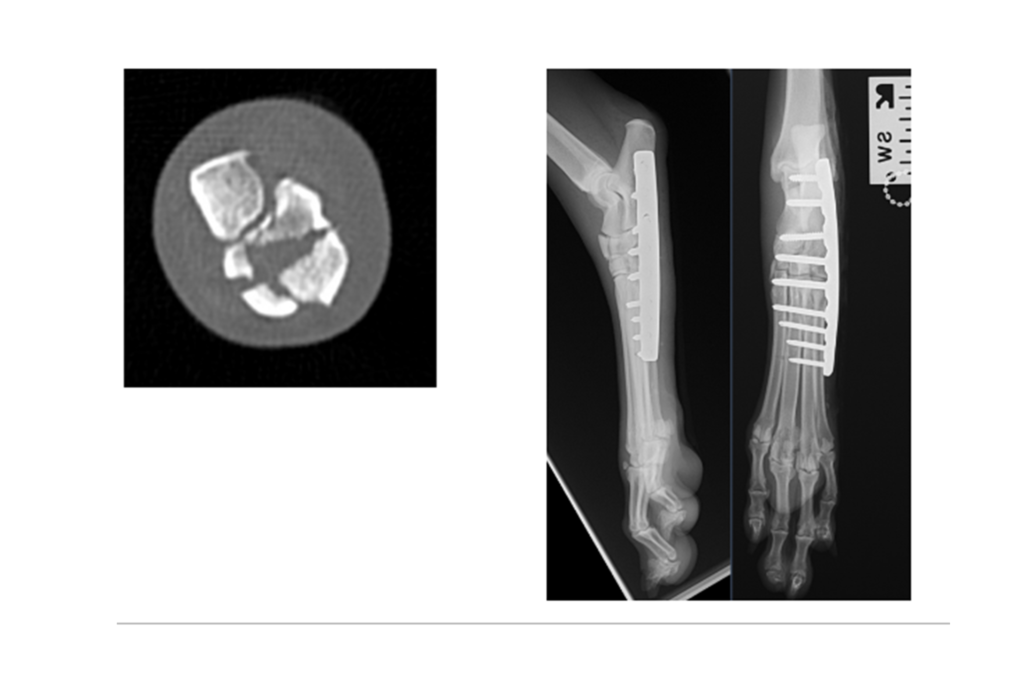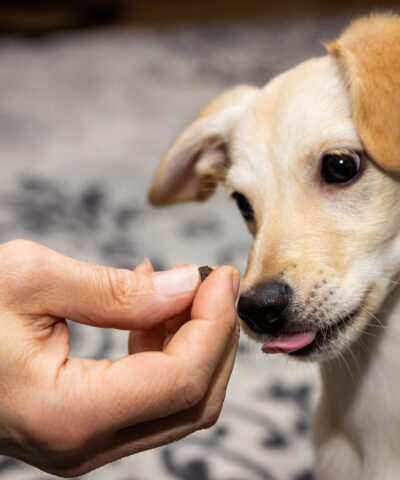Your dog’s well-being is likely one of your top priorities. When it comes to ensuring that every tail wag is as lively as the first, understanding their joint health and mobility issues is vital to their overall health. Just as our bodies recognise the occasional stiffness or need for extra TLC as we age, our dogs face similar joint and mobility challenges. In this guide, we’ll tackle everything you need to know about caring for your canine’s joints – from understanding potential issues to taking preventive measures, identifying problems, exploring treatment options, and making subtle yet impactful changes to your pup’s lifestyle.
So join us as we explore the world of dog joint care so we can potentially help your four-legged friend stay agile and happy by your side for years to come. After all, isn’t a dog’s zest for life the perfect reminder that every leap counts?
Understanding Dog Joint Health
The Hinges of Happiness
Your dog’s joints are engineering marvels, allowing fluid movements that enable those memorable sprints and joyful bounces. But what happens when these hinges start to creak and groan? Understanding the anatomy of a dog’s joints is the first step in appreciating the need for vigilant care.
Healthy joints are cushioned by cartilage and synovial fluid, which helps reduce friction between the moving parts. Many factors can disrupt this dynamic and complex environment, ultimately leading to discomfort and reduced mobility.
Common Canine Joint Issues
Our loyal companions are prone to various joint-related and mobility problems, with canine osteoarthritis (arthritis as we know it!) being one of the most prevalent conditions. This degenerative joint disease, often characterised by swelling, pain, and stiffness, can affect dogs of all ages but is more common in seniors or those with historical injuries.
In addition to arthritis, dogs can also suffer from other ailments such as hip dysplasia, knee ligament injuries, and elbow dysplasia, all of which merit varying attention and care.
Factors Influencing Joint Health
Several factors can impact your dog’s joint health trajectory. Genetics play a significant role; certain breeds are genetically predisposed to joint issues, with larger breeds particularly at risk.
Nutrition also plays a key role, as an imbalanced diet or overfeeding can lead to excessive weight gain, placing added stress on the joints. Exercise, or lack thereof, can support or harm joint health if not managed appropriately. It’s all about creating a thoughtful, holistic approach tailored to your dog’s breed, age, and lifestyle.
Preventive Measures for Pristine Paws
The adage ‘prevention is better than cure’ rings especially true when safeguarding your dog’s joint health. There are several proactive steps you, as a pet owner, can take to keep joint issues at bay.
A Balanced Diet for a Balanced Gait
Nutrition is the foundation of health, and joint well-being is no exception. High-quality dog food, formulated to support joint health, can be incredibly beneficial. Look out for diets rich in omega-3 fatty acids, glucosamine, and chondroitin – compounds known to sustain joint integrity.
Overfeeding and unhealthy snacking, however endearing, are potential pathways to joint problems. Ensure your pet stays at a healthy weight, leaning on portion control and nutritious treats to maintain a sleek physique.
Exercise, The Best Medicine—In Moderation
A sedentary lifestyle can lead to weakened muscles and stiff joints. Excessive running or rough play can have equally detrimental effects. Engage your furry friend in regular, low-impact exercises like swimming or brisk walks to keep their joints lubricated and their muscles toned.
When Supplements Are the Supporting Cast
Supplements are not a replacement for a wholesome diet and proper exercise, but they can be valuable allies in your quest for canine joint health. Many pet owners swear by glucosamine, chondroitin, and omega-3 fatty acids for invigorating their pup’s joints.
Always consult your vet before starting your dog on a supplement regimen, as individual needs and effective dosage can vary widely.
Identifying Joint Problems Early On
Our dogs are masters at masking discomfort, often to avoid worrying their beloved humans with their struggles. It’s our job to be vigilant and recognise the subtle signs of joint issues before they escalate.

Signs to Watch For
Limping, stiffness, and difficulty rising or climbing are common indicators that their joints are not working as well as they should be. You may even notice a change in their gait or a reluctance to engage in activities they usually enjoy. Pay close attention; the earlier an issue is addressed, the better the potential outcomes.
When to Call in the Professionals
Trusting your instincts and acting promptly can significantly affect your dog’s recovery. If your dog is showing persistent signs of joint discomfort, a trip to the vet is in order. They can provide a definitive diagnosis and recommend an appropriate treatment plan.
Remember, it’s better to follow up with a professional sooner rather than later about a persistent limp. Joint care should never be based on guesswork or wishful thinking regarding your pet’s comfort.
Treatment Options for Tender Joints
Knowledge truly is power when treating your dog’s joint issues. Understanding the available options will enable you to make informed decisions about your companion’s care.
Medications That Make Movement Mundane
Pharmaceutical interventions are often the first defence against joint pain and inflammation. Non-steroidal anti-inflammatory drugs (NSAIDs) can offer substantial relief, but they’re not without potential side effects. Always administer these medications under the guidance of a veterinarian.
Physical Therapy, Rehabilitate Like a Pro
Specialist physiotherapy has been a critical facet in humans regarding injury rehabilitation and preventative care against mobility issues for years. Thankfully, it is also now starting to catch on in dogs (and cats). This is excellent news because it helps with joint and mobility issues in dogs. Specialist centres can provide things like dog physio, hydrotherapy, laser therapy, and specific exercises, all of which can improve joint functionality and overall mobility.
Surgical Interventions, A Lasting Solution
In severe cases where joint damage is extensive, surgery may be the most viable option. Procedures like total hip replacement or cranial cruciate ligament repair can radically alter your dog’s quality of life for the better.
Implementing a Joint-Friendly Lifestyle
Small, thoughtful changes can significantly impact your dog’s comfort. In addition to specific treatments, consider the overall environment through which your pet navigates daily.
Creating a Comfortable and Accessible Space
Make your home a haven for your dog’s joints by providing supportive bedding, avoiding slippery surfaces, and ensuring easy access to their favourite spots. Ramps or steps can help your pet avoid strenuous jumps and climbs, preserving their joints’ integrity over time.
Improving Mobility and Fun with Toys
Incorporate interactive toys that encourage movement and play within reason. Puzzle toys or gentle fetch games can keep your dog engaged physically without overstressing its joints.
Weight Maintenance and Monitoring
Regular weigh-ins and diet adjustments can be effective in combating joint issues. A lean dog is a healthy dog with joints that can function without the encumbrance of excess weight.
Case Study: Cosy the Lurcher
My oldest dog, Cosy, a Lurcher who is a bit fragile, as is typical of her breed, has taught me much about managing joint care in dogs. So much so that a very highly respected vet recently said, ‘You just about have an honorary degree in veterinary science with all you have been through with Cosy.’
At the age of 5, Cosy broke her ankle in 4 places, which required a partial arthrodesis (screws in the joint). A year later, she suffered a very common Lurcher Greyhound injury of breaking a toe so severely it needed removal. Alongside this, she dislocated the adjacent toe.
These two significant injuries across front and back legs, alongside the onset of age-related arthritis (she is now 9), could have created real difficulties. However, the opposite has been the case, with her as fit and healthy as you could ever want.
We believe our approach has been the gold-star route to managing Cosy’s joint care and mobility needs. It has been multidisciplinary, involving a combination of nutrition, exercise, physiotherapy, supplements, and a little vet support.
- High-Quality Nutrition—Cosy is on the Green Pantry Chicken Diet. Initially, we chose this diet because its hypoallergenic nature was great for her sensitive tummy. However, we have found that the high-quality natural ingredients have helped keep her in excellent condition and at the correct weight, fully providing for her nutritional needs. All of these are important when managing dog joint or mobility issues.
- Exercise—Regular walks of at least 20 minutes are crucial multiple times daily to help keep Cosy fit, vigorous, and mobile. In addition, we always find time for at least one long walk a week (1 hour plus).
- Physiotherapy – Of all the best-kept secrets to helping dog mobility, this is it. Physio has been crucial to human rehab and mobility retention for years, but it is only catching on for dogs. We were first recommended it by the surgeon (Swift Referrals) who did Cosy’s ankle plate, and it’s been the best thing we could have done for her. Cosy goes to Operation K9 (who are excellent, by the way). They start by giving her a laser therapy session, which helps reduce inflammation associated with arthritis and dog joint issues and warms her up before going to the hydrotherapy treadmill, where we focus on strength and general mobility. Cosy goes once a fortnight, and it has done wonders for her in terms of rehabilitation after her ankle plate and keeping her fit and agile as she ages.
- Joint and mobility supplements—We use a bit of a combo here; we add the Green Pantry Herbal Joint Care supplement to her food and then give YuMove as a separate tablet.
- Vet support—The final piece in the puzzle is the vets. They may offer various support services, but Cosy goes for something called Librela every three months. Librela is a new drug for pain relief in dogs with osteoarthritis. It targets nerve growth factors to inhibit pain signals.
This multidisciplinary approach has worked beyond anything we could have hoped for, and at 9 ½ years old, her physical health and fitness remains at peak level.
Conclusion: The Journey to Jovial Joints
Caring for your dog’s joints is an ongoing commitment to their undiluted joy and freedom of movement. Whether preparing a nutrient-packed meal, engaging in a therapeutic session of tug-of-war, or simply spending quality time together, each step you take contributes to their long-term well-being.
Approach joint care holistically, combining the insights shared in this guide with the unique needs of your precious pup. Remember, an ounce of prevention is worth a pound of cure – your pet’s future self will thank you with countless tail wags and heartwarming cuddles.
In partnership with your vet, and with the bond you share with your dog as your guiding light, take charge of their joint health. Together, you can craft a life tapestry that weaves well-being and vitality into every shared moment. After all, in the story of a dog’s life, it’s the jump, not the landing, that’s truly the measure of happiness.
Written By Tom @ Green Pantry (Assisted by Cosy the Lurcher)





